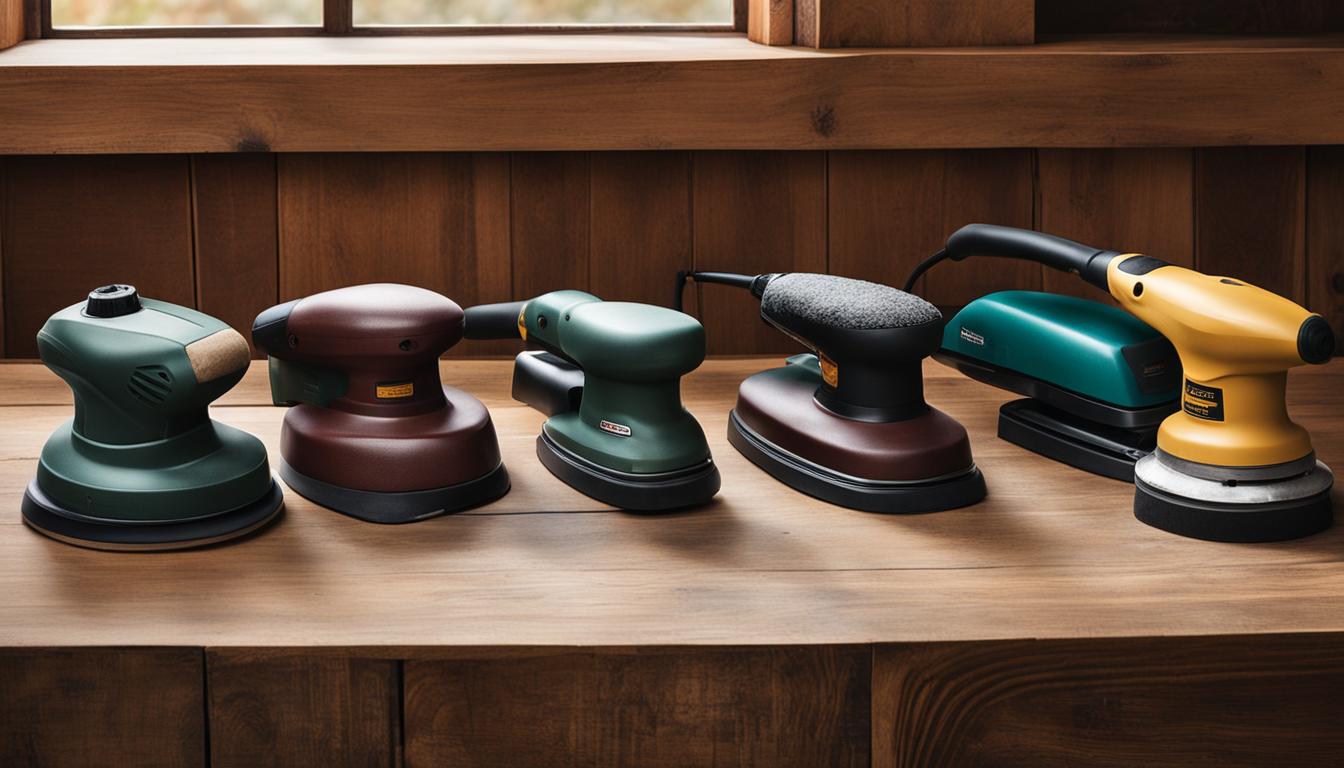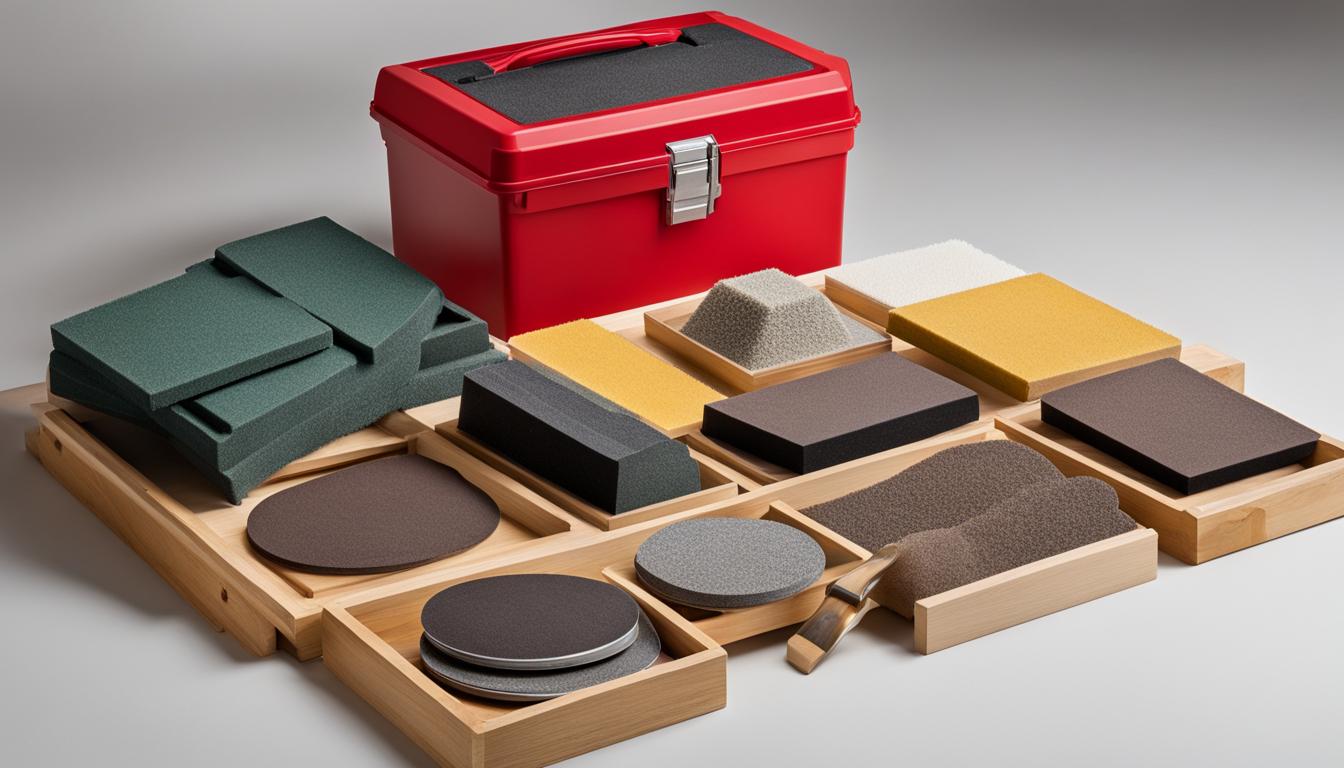Cabinet refinishing projects often start with sanding and choosing the right sander can make all the difference in achieving a flawless finish. Understanding the different types of sanders available and their specific uses is crucial. In this article, I will explore the best types of sanders for cabinets and provide valuable tips on choosing and using the perfect sander for your project.
Key Takeaways:
- There are different types of sanders for cabinets, each with its own unique features and uses.
- The random orbital finishing sander is widely regarded as the best option for cabinet refinishing due to its versatility and efficiency.
- Other sanders like orbital sanders, belt sanders, detail sanders, and manual sanding techniques also have their place in cabinet refinishing projects.
- Choosing the right sandpaper and practicing proper sanding techniques are essential for achieving a smooth and even surface.
- Having the necessary tools and following helpful tips can enhance your cabinet sanding experience.
Types of Sanders for Finishing Cabinets
When it comes to finishing cabinets, using the right sander is essential for achieving a smooth and professional result. There are different types of sanders specifically designed for cabinet sanding tasks. Understanding their unique features and benefits will help you make an informed decision when selecting the perfect tool for your project.
1. Random Orbital Finishing Sander
The random orbital finishing sander is a versatile and widely used power tool for cabinet refinishing. It combines rotary and orbital motions, creating a high-speed spin with a slight wiggling action. This sander is known for its ability to remove imperfections and achieve a flawless finish. It uses sandpaper discs attached to the bottom, providing efficient and controlled sanding with one or two hands. Some models even have built-in dust extraction systems, keeping your workspace cleaner.
2. Orbital Finishing Sander
The orbital finishing sander, also known as a palm sander or sheet sander, is another popular choice for cabinet sanding. It features a square-shaped vibrating head that moves in tiny orbits, providing a smoother surface. While easy to control, it’s important to use this sander properly to avoid leaving swirl or hatch marks on the wood. It accepts standard square sheets of sandpaper and is particularly effective for sanding flat surfaces.
3. Belt Sander
Although not commonly used as a finishing sander for cabinets, the belt sander can be useful for the preliminary removal of old finishes and stubborn coatings. It’s a powerful and aggressive tool with a sandpaper belt that runs between pulleys. The belt sander is ideal for sanding large areas and thick substances, making it perfect for heavy material removal. However, caution should be exercised to prevent over-sanding or damaging the wood.
4. Detail Finishing Sander
When it comes to reaching tight corners and angles in cabinets, the detail finishing sander is the ideal tool. This small and portable sander is designed for sanding intricate details and small areas that are challenging to reach with larger sanders. With interchangeable sanding pads of different shapes, the detail sander offers versatility and precision in cabinet refinishing projects.
5. Manual Sanding
While power sanders are efficient, manual sanding remains a valuable technique for cabinet refinishing. Hand sanding allows for greater control and precision, especially in hard-to-reach areas. It can also be used to apply the final delicate touches to the wood. Manual sanding complements power sanding, resulting in a smooth and flawless finish. Choosing the right grit sandpaper and using proper sanding techniques are crucial for optimal results.
Each type of sander has its own advantages and is suitable for different cabinet sanding tasks. Depending on your specific needs, budget, and project requirements, you can choose the perfect sander that will help you achieve professional-quality results.
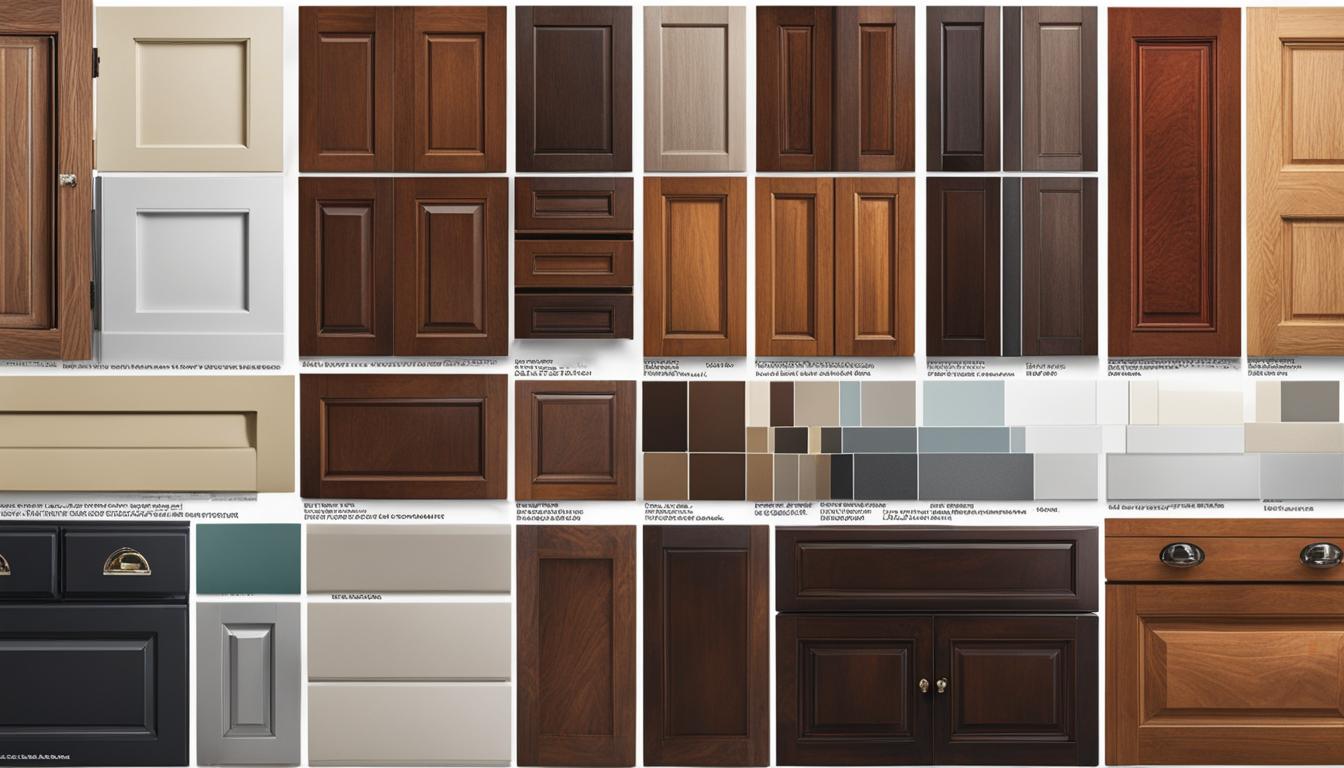
Random Orbital Finishing Sander
The random orbital finishing sander is a handheld machine that combines rotary and orbital motions. It spins at a high speed while creating a slight wiggling action, resulting in an efficient and smooth sanding process.
This type of sander is widely regarded as the best sander for finishing cabinets due to its power, speed, and ability to remove imperfections. It uses sandpaper discs that attach to the bottom and can be controlled with one or two hands. Some models also have dust extraction capabilities, making them convenient and less messy to use.
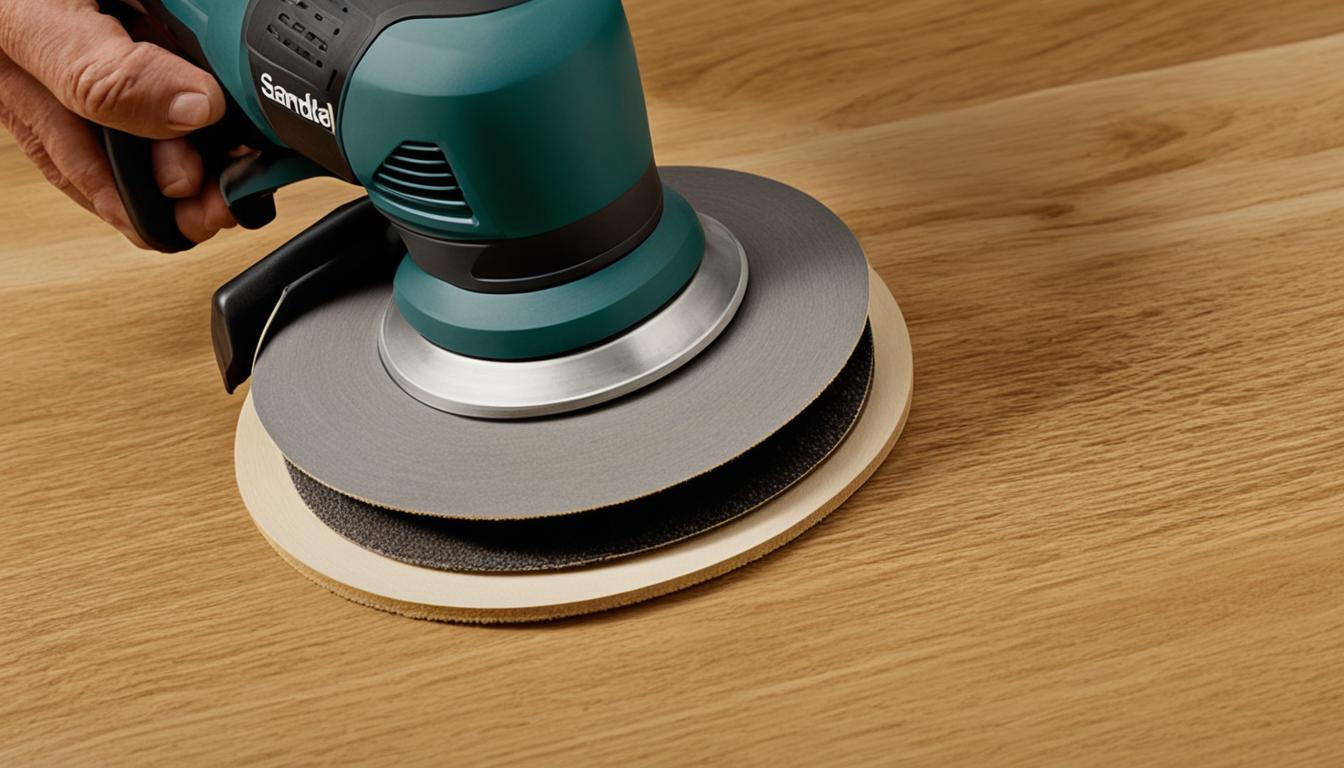
When using a random orbital finishing sander for cabinet refinishing, it is essential to choose the right sandpaper grit for the task at hand. Coarser grits, such as 80 or 120, are suitable for removing old finishes or tackling rough surfaces. Finer grits, like 180 or 220, are ideal for achieving a smooth and polished result.
The random orbital sander’s versatility makes it perfect for sanding cabinets of various sizes and shapes. Its ergonomic design and ease of use allow for comfortable handling and maneuverability. Whether you’re sanding large cabinet surfaces or intricate details, the random orbital finishing sander provides consistent and professional-quality results.
Advantages of the Random Orbital Finishing Sander:
- Powerful and efficient sanding performance
- Smooth and consistent finish with minimal swirl marks
- Ability to remove imperfections and blemishes
- Versatility for sanding cabinets of different sizes and shapes
- Ergonomic design for comfortable and controlled operation
- Optional dust extraction capabilities for a cleaner work environment
Summary:
The random orbital finishing sander is the go-to choice for professionals and DIY enthusiasts seeking the best sander for cabinets. Its combination of power, speed, and versatility ensures efficient and effective sanding, resulting in beautifully finished cabinets. Whether you’re refinishing kitchen cabinets or restoring antique furniture, the random orbital finishing sander will help you achieve stunning results without compromising on quality.
Orbital Finishing Sander
The orbital finishing sander, also known as a palm sander or sheet sander, is another handheld machine used for cabinet sanding. It features a square-shaped head that vibrates in tiny orbits to create a smoother surface. The orbital sander is commonly used for preparing cabinets and furniture for painting or staining, making it an essential tool in any cabinet refinishing project.
The orbital sander is easy to control, providing users with the precision required to achieve a professional finish. However, it is important to note that if not used properly, it may leave swirl or hatch marks on the wood. To avoid this, it is recommended to keep the sander in constant motion and apply even pressure during sanding.
This type of sander accepts standard square sheets of sandpaper, making it convenient and cost-effective. It is particularly useful for sanding flat surfaces, such as cabinet doors. The orbital sander’s vibratory motion ensures consistent sanding across the entire surface, resulting in a uniform and smooth finish.
Whether you are a DIY enthusiast or a professional cabinet refinisher, the orbital finishing sander is a valuable tool in your arsenal of cabinet sanding tools. Its versatility and ease of use make it an excellent choice for achieving the perfect surface preparation before applying paint or stain.
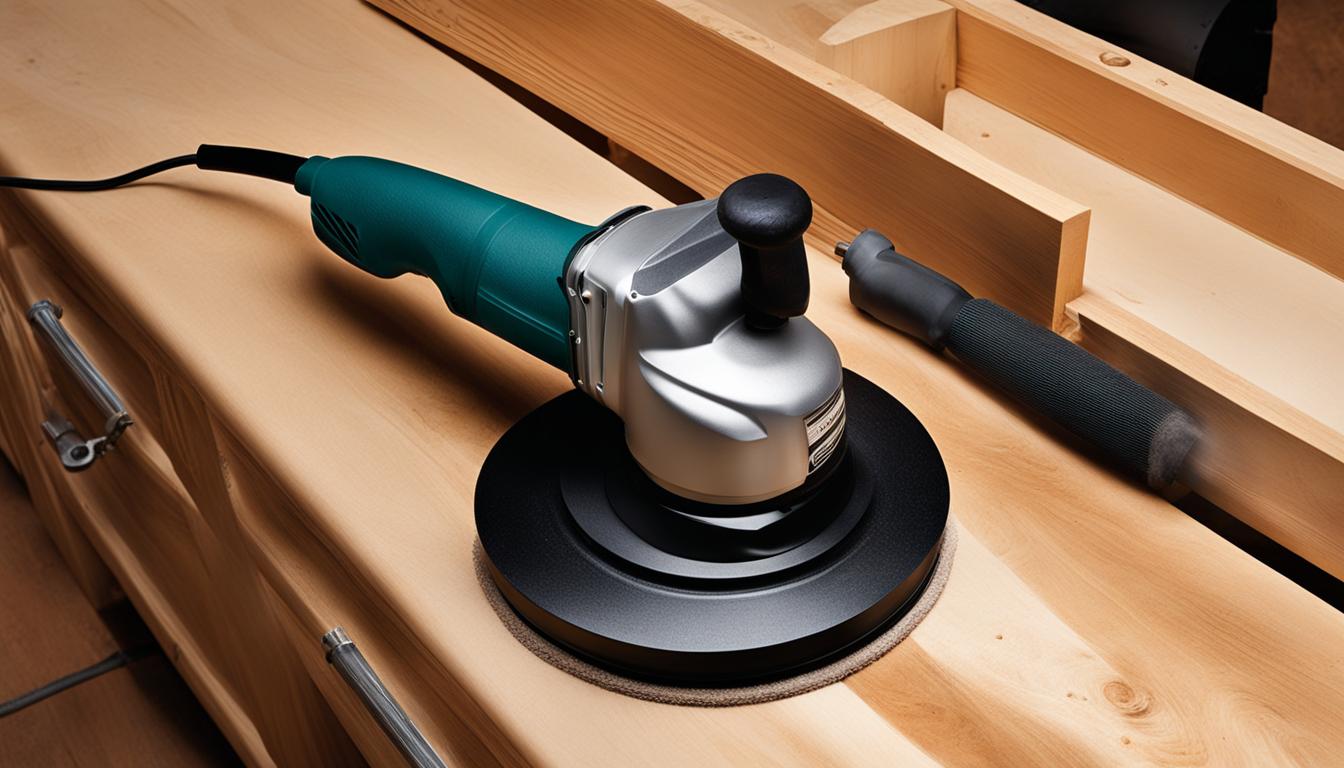
Affordable and Effective: The Orbital Finishing Sander
The orbital finishing sander provides a cost-effective and efficient solution for cabinet sanding. Its straightforward operation and compatibility with standard sandpaper sheets make it an accessible tool for both beginners and experienced professionals. With the orbital sander, you can achieve a smooth, high-quality finish on your cabinets without breaking the bank.
The orbital finishing sander is my go-to tool for preparing cabinets for refinishing. Its square-shaped head and vibratory motion allow me to sand large surfaces quickly and evenly. It’s a reliable and budget-friendly option that consistently delivers excellent results.
Belt Sander
The belt sander is a powerful and aggressive tool that is typically used for heavy material removal. It features a sandpaper belt that runs between pulleys and is designed to tackle large areas and thick substances. While the belt sander is not commonly used as a finishing sander for cabinets, it can be useful for preliminary removal of old finishes and stubborn coatings. It is ideal for sanding long, flat pieces of wood and provides brute strength for more demanding sanding tasks.
“The belt sander is a game-changer when it comes to heavy material removal. Its robust design and powerful motor make it perfect for sanding large surfaces efficiently.” – James Thompson, Professional Woodworker
Detail Finishing Sander
The detail finishing sander is a small and portable sander that is specifically designed for reaching tight corners and angles in cabinets, furniture, and other woodworking projects. Its compact size and versatility make it a valuable tool for cabinet refinishing projects.
The detail finishing sander is the smallest member of the finishing sander family and often comes with interchangeable sanding pads of different shapes. This feature allows for sanding intricate details and small areas that are challenging to reach with larger sanders. With its precision and maneuverability, the detail finishing sander ensures that every nook and cranny of your cabinets receives the attention it deserves.
Whether you need to sand the edges of cabinet doors or tight corners on decorative molding, the detail finishing sander is the perfect solution. Its gentle yet effective sanding action delicately smooths surfaces without damaging delicate or intricate woodwork.
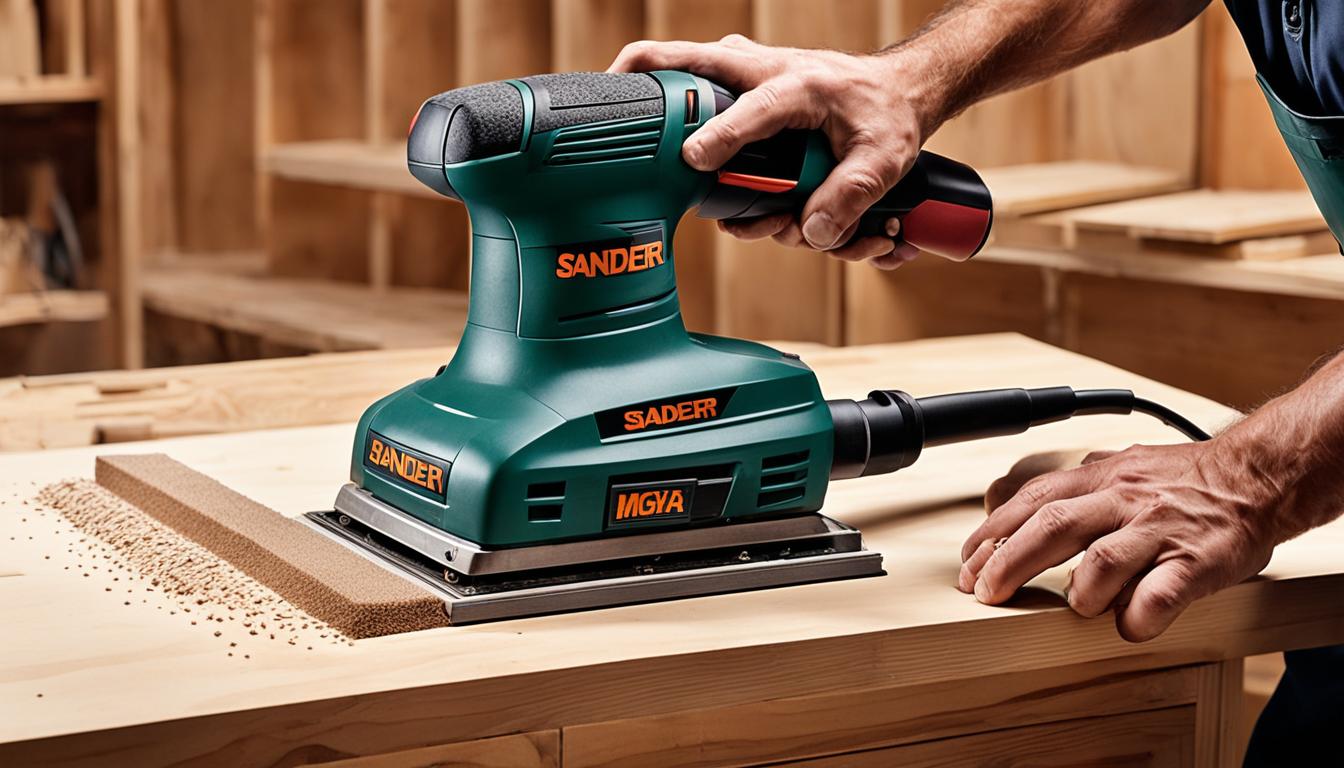
With the detail finishing sander, you have complete control over your cabinet sanding process. Its lightweight design allows for comfortable handling, minimizing hand fatigue during extended use. This versatile tool is essential for achieving a flawless finish and bringing out the natural beauty of your cabinets.
Manual Sanding
While power sanders are efficient and time-saving, manual sanding still has its place in cabinet refinishing. Hand sanding allows for greater control and precision, especially in hard-to-reach areas. It can also be a suitable method for applying the final delicate touches to the wood. Manual sanding can complement the use of power sanders to achieve a smooth and flawless finish.
When engaging in manual sanding, proper techniques and tools are essential for optimal results. Start by selecting the right grit sandpaper based on the level of sanding required. Coarser grits, such as 80 or 100, are ideal for initial rough sanding to remove imperfections and previous finishes. As you progress towards your desired smoothness, gradually switch to higher grits like 150, 180, or 220 for finer sanding.
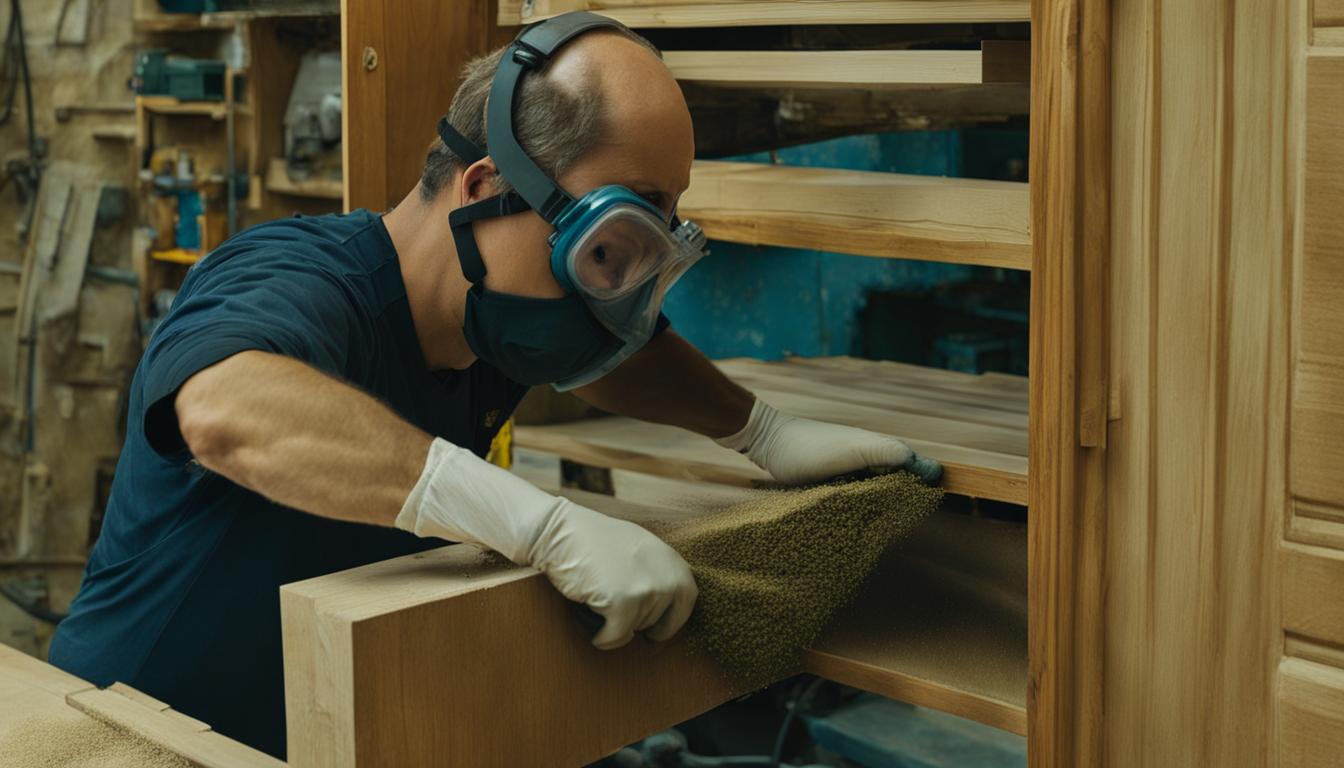
Image: Manual sanding
When manual sanding, it’s important to follow proper techniques:
- Hold the sandpaper firmly, folding it into thirds for a comfortable grip.
- Apply even pressure and sand in the direction of the wood grain.
- Use long, fluid strokes to prevent uneven sanding marks.
- Regularly check the surface for smoothness and adjust your sanding technique as needed.
- Ensure you wear a dust mask and eye protection to protect yourself from dust.
By combining manual sanding with power sanding techniques, you can achieve a professional-level finish on your cabinets. The careful attention to detail and precision offered by manual sanding can truly elevate the quality and appearance of your cabinet refinishing project.
All About Sandpaper
Sandpaper plays a crucial role in cabinet refinishing projects, as it helps achieve a smooth and even surface. Choosing the right sandpaper is essential for optimal results. Here, I will discuss the different aspects of sandpaper and provide valuable insights into selecting the perfect sandpaper for your cabinet refinishing needs.
Sandpaper Sizes and Grits
Sandpaper comes in various sizes and grits, allowing you to customize your sanding process. The size of the sandpaper refers to its dimensions, while the grit represents the coarseness or fineness of the abrasive particles.
For cabinet sanding, it is recommended to start with a coarser grit to remove imperfections and the old finish. As you progress, switch to finer grits to achieve a soft and refined texture. Popular grits for cabinet sanding include 100, 180, and 220.
Quality Sandpaper Brands
Using high-quality sandpaper ensures better performance and durability during cabinet sanding. Some respected sandpaper brands known for their reliability and effectiveness include Abralon, Abranet, and Autonet. These brands offer a wide range of options suitable for various cabinet refinishing projects.
Sandpaper grits can be best understood through a comparative table. The table below provides a detailed breakdown of common sandpaper grits, their corresponding abrasive particle sizes, and their recommended uses.
| Grit | Abrasive Particle Size (microns) | Recommended Use |
|---|---|---|
| 60 – 80 | 241 – 190 | Heavy material removal, leveling uneven surfaces |
| 100 – 120 | 145 – 115 | Removing deep scratches, shaping and smoothing |
| 150 – 180 | 105 – 84 | Preparing surfaces for paint or stain |
| 220 – 240 | 73 – 63 | Final sanding before finishing |
Note: The micron values provided are approximate conversions for reference purposes.
Tips for Sanding with Sandpaper
- Use light pressure while sanding to avoid applying excess force.
- Move the sandpaper in smooth, even strokes, following the grain of the wood.
- Change the sandpaper frequently to maintain its effectiveness.
- Always wear protective gear, such as safety glasses and a dust mask, to prevent injury and inhalation of dust particles.
Pro Tip: Before sanding, clean the cabinet surface thoroughly to remove any dust or debris that could damage the sandpaper or affect the sanding process.
By understanding the different sizes and grits of sandpaper, as well as the importance of using quality brands, you can enhance your cabinet refinishing projects. Remember to follow proper sanding techniques and take necessary safety precautions for a successful and satisfying outcome.
Tools and Tips
When undertaking a cabinet sanding project, having the right tools and following helpful tips can significantly contribute to your success. The following are essential tools and useful tips for achieving optimal results:
Essential Tools
Here are the necessary tools you should gather before starting your cabinet sanding project:
- A random orbital or orbital sander
- Appropriate sandpaper sheets or discs
- A dust mask
- A dustpan or vacuum
- An extension cord
- Safety glasses
- Earplugs
Tips for Success
To ensure a successful cabinet sanding project, consider the following tips:
- Establish a dedicated workspace: Clear the area and create a designated space for sanding your cabinets. This will minimize interruptions and provide you with a clean, well-organized environment.
- Clean the cabinets thoroughly: Remove any dirt, dust, or debris from the surface of the cabinets before sanding. This will prevent particles from getting trapped in the sandpaper and ensure a smooth finish.
- Practice on a test piece: If you’re using a new sander or trying a different sanding technique, it’s a good idea to practice on a test piece of wood first. This will allow you to familiarize yourself with the machine’s performance and get a feel for the sanding process.
- Consider multiple sanders: Depending on the complexity of your cabinet project, it may be beneficial to have multiple sanders on hand. For example, using a random orbital sander for larger flat surfaces and a detail finishing sander for intricate details can enhance your sanding capabilities and produce superior results.
By equipping yourself with the right tools and following these helpful tips, you’ll be well-prepared to tackle your cabinet sanding project with confidence and achieve professional-quality results.
Recommended Sanders for Cabinets
When it comes to choosing the best sander for cabinets, individual preferences play a significant role. However, there are reputable options available in the market that are worth considering. Two popular choices for cabinet sanding tools are electric orbital sanders and pneumatic orbital sanders. These sanders are known for their versatility and reliability, making them suitable for a wide range of cabinet refinishing projects.
Mirka Ceros and Deros are prominent brands known for their exceptional performance and quality in the field of cabinet sanding tools. These brands offer a variety of electric orbital sanders that come with features designed to enhance efficiency and deliver outstanding results. Each sander in their collection is meticulously crafted to cater to specific needs and requirements, ensuring a smooth and efficient sanding experience for cabinet refinishing projects of any scale.
To complement their electric orbital sanders, Mirka also offers a range of pneumatic orbital sanders. Pneumatic sanders are known for their power and durability, making them suitable for heavy-duty sanding tasks. These sanders use compressed air to operate, providing consistent and reliable performance even in demanding situations. They are often preferred by professionals for their ability to handle rigorous sanding jobs with ease and precision.
When selecting a sander for your cabinet refinishing project, it is essential to consider factors such as the scale of the project, your specific sanding needs, and your budget. By choosing a sanding tool that aligns with these factors, you can ensure a smooth and efficient sanding process. Take the time to review different options, read customer reviews, and compare features to make an informed decision that will help you achieve the best results for your cabinets.
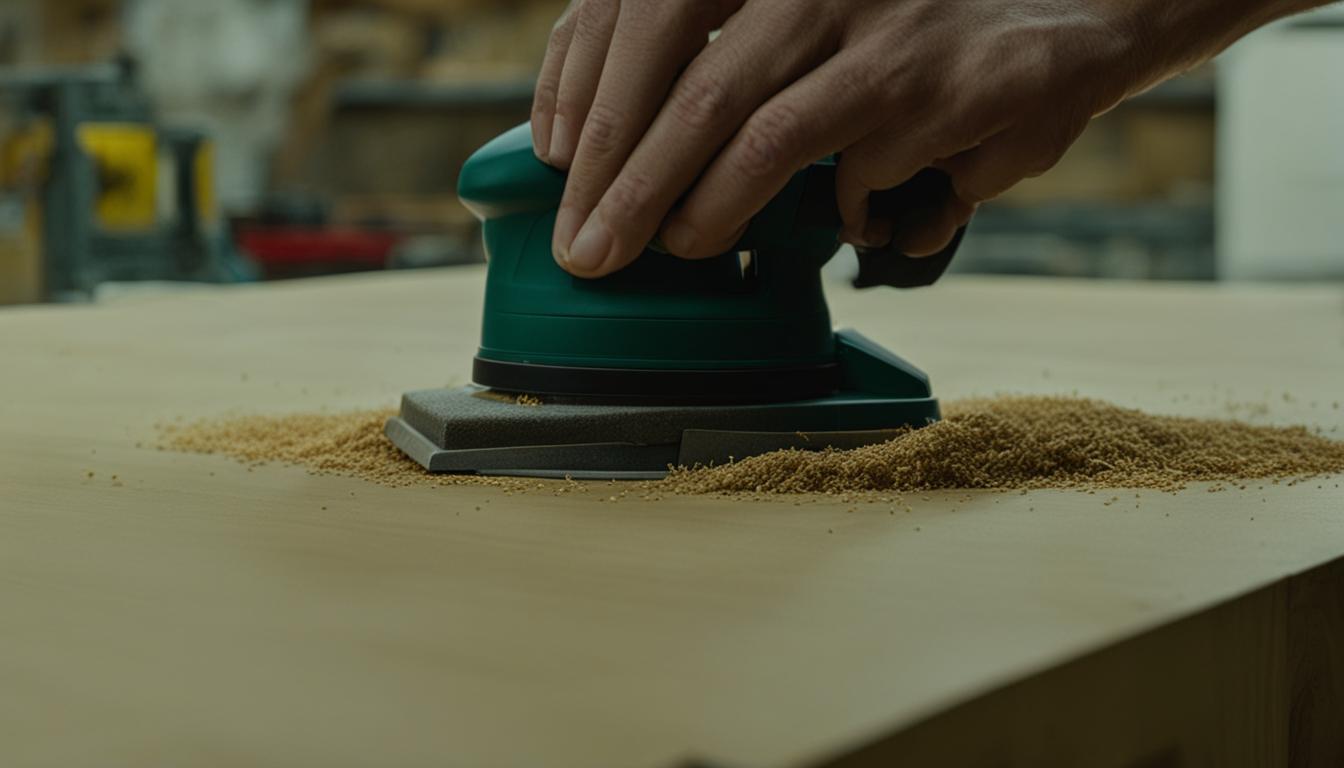
In the next section, we will discuss sanding and finishing techniques specifically tailored for cabinet doors, ensuring a professional and flawless outcome.
Sanding and Finishing Techniques for Cabinet Doors
Sanding and finishing cabinet doors require specific techniques to achieve professional-looking results. Proper surface preparation is crucial before sanding, which involves stripping old finishes or degreasing the cabinets.
Sanding should be done in smooth and even motions, gradually progressing from coarser to finer grits. This ensures the removal of imperfections and creates a smooth surface for the finish. Using a random orbital finishing sander or an orbital sander with the appropriate grit sandpaper is recommended for this process.
To maintain a clean workspace and prevent dust from settling on the freshly sanded surfaces, vacuuming or using a dust extraction system is essential. This reduces the risk of dust particles affecting the quality of the final finish.
Once the sanding process is complete, applying the chosen finish is the next step. Whether it’s paint, stain, or sealant, it’s important to follow the manufacturer’s instructions for proper application. This ensures a durable and aesthetically pleasing result.
Remember that each cabinet refinishing project may require different sanding techniques and finishing products based on the type of wood, desired outcome, and personal preferences. Experimenting with different sanding techniques and finishes on test pieces before working on the actual cabinet doors can help you find the perfect combination for your project.
Conclusion
Choosing the right sander for cabinets is crucial for achieving a flawless finish. When it comes to cabinet refinishing, the random orbital finishing sander stands as the top choice due to its versatility and efficiency. However, other types of sanders also have their place in cabinet sanding projects.
Orbital sanders, belt sanders, detail sanders, and even manual sanding techniques each offer unique benefits and functions. Understanding the characteristics and uses of these different sanders will empower you to make an informed decision based on the specific requirements of your cabinet refinishing project.
By following proper sanding techniques and utilizing the right tools, you can transform your cabinets into beautifully refurbished pieces of furniture. Whether you opt for the power and precision of an electric sander or prefer the control of manual sanding, the key is to work methodically, progressing from coarser to finer grits, and paying attention to every detail. With patience and care, you can achieve professional-quality results that will make your cabinets look as good as new.
FAQ
What are the different types of sanders for finishing cabinets?
The different types of sanders for finishing cabinets include random orbital finishing sander, orbital finishing sander, belt sander, detail finishing sander, and manual sanding.
What is a random orbital finishing sander?
A random orbital finishing sander is a handheld machine that combines rotary and orbital motions. It is widely regarded as the best sander for finishing cabinets due to its power, speed, and ability to remove imperfections.
What is an orbital finishing sander?
An orbital finishing sander, also known as a palm sander or sheet sander, is a handheld machine used for cabinet sanding. It features a square-shaped head that vibrates in tiny orbits to create a smoother surface.
What is a belt sander?
A belt sander is a powerful and aggressive tool used for heavy material removal. While not commonly used as a finishing sander for cabinets, it can be useful for the preliminary removal of old finishes and stubborn coatings.
What is a detail finishing sander?
A detail finishing sander is a small and portable sander specifically designed for reaching tight corners and angles in cabinets and furniture. It is perfect for sanding intricate details and small areas that are challenging to reach with larger sanders.
Is manual sanding still necessary for cabinet refinishing?
Yes, manual sanding can complement the use of power sanders to achieve a smooth and flawless finish, especially in hard-to-reach areas. It allows for greater control and precision and is suitable for applying the final delicate touches to the wood.
What type of sandpaper should I use for cabinet sanding?
It is recommended to start with a coarser grit to remove imperfections and old finish, and gradually progress to finer grits for a soft and refined texture. Popular grits for cabinet sanding include 100, 180, and 220.
What tools do I need for cabinet sanding?
Essential tools for cabinet sanding include a random orbital or orbital sander, appropriate sandpaper sheets or discs, a dust mask, a dustpan or vacuum, an extension cord, safety glasses, and earplugs.
Which sanders are recommended for cabinets?
Electric orbital sanders and pneumatic orbital sanders are popular choices for their versatility and reliability. Brands like Mirka Ceros and Deros are known for their performance and quality.
What sanding and finishing techniques should I use for cabinet doors?
Proper surface preparation, such as stripping old finishes or degreasing the cabinets, is essential before sanding. Sanding should be done in smooth and even motions, gradually progressing from coarser to finer grits. Vacuuming or using a dust extraction system helps keep the workspace clean. Applying the chosen finish should be done according to the manufacturer’s instructions.
How can I achieve a flawless finish when sanding cabinets?
Choosing the right sander for cabinets is crucial for achieving a flawless finish. Understanding the characteristics and uses of each sander will help you make an informed decision. By following proper sanding techniques and using the right tools, you can transform your cabinets into beautifully refurbished pieces of furniture.

